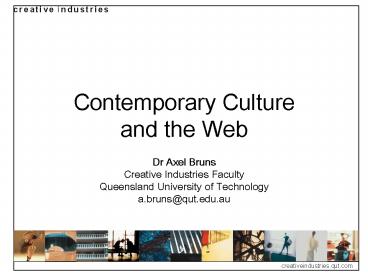Contemporary Culture and the Web PowerPoint PPT Presentation
Title: Contemporary Culture and the Web
1
Contemporary Cultureand the Web
- Dr Axel Bruns
- Creative Industries Faculty
- Queensland University of Technology
- a.bruns_at_qut.edu.au
2
A Tale of Two Webs
- Web development in divergent directions
- towards greater commercialisation high
production values, broadband-ready, but
relatively non-interactive packaged content - towards more user co-creativity highly
interactive, open-ended and unfinished forms,
emerging from the grassroots
3
A From Homepages to Blogs
- Homepages
- began as basic information pages, with personal
details, favourite links, etc. - usually static, using plain HTML, infrequently
edited, non-interactive - Blogs
- ranging from public diaries to personal
commentary on current events - dynamic, database-driven, frequently updated,
enabling user commentary and interlinkage with
other sites (e.g. snurb.info) - embedded in a vast, loose network of blogs the
blogosphere
4
B From Community News to Open News
- Community News
- began as a simple way of updating current events
of interest to a specific group - usually on static HTML pages, updated by a small
group of enthusiasts, non-interactive - Open News
- large-scale Web publications created and edited
by the community itself - dynamic, database-driven content enabling any
user to submit new content or comment on
published stories, or even to help edit submitted
content (e.g. Kuro5hin.org)
5
C From Resource Sites to Wikis
- Resource sites
- began as collections of background information on
specific topics - usually on static HTML pages, maintained by a
small group of experts in their field,
non-interactive - Wikis
- collaboratively edited, database-driven
encyclopaedias on specific topics - drawing on the expertise of large user
communities which are able to add and edit
content at any time (e.g. the Wikipedia)
6
Common Traits
- Technology
- reliance on database backends makes sites
dynamic, interactive, and searchable - such technology is now in the hands of end users,
not just corporations (users are often the
earliest adopters) - Community
- move from individual to communal authorship
users comment on and edit one anothers work
(sites resemble palimpsests) - open source model trust in the power of
eyeballs in improving the quality of content - heterarchical rather than hierarchical power
structures - Creativity
- move from mere interactivity to intercreativity
(Tim Berners-Lee) - free contribution of ones work in support of a
greater good (a creative commons)
7
Beyond the Webpage
- Change in the basic unit of information
- from the individual page to the individual entry
- e.g. a blog posting
- e.g. a news story
- e.g. an encyclopedia entry
- towards syndication of information
- e.g. through RSS (Rich Site Summary)
newsfeeds(see RSS feed for BBC News ? on
snurb.info) - e.g. through feed aggregator and analyser
services(see Daypop rankings of most popular
topics and links) - e.g. through TrackBack and other networking
tools(see TrackBacks in Lawrence Lessigs blog)
8
Information as Virus
- Information becomes viral
- detached from its traditional host, the Webpage
- carried rapidly through multiple channels
- attaching itself to various hosts in mutated
forms - Content is detached from format
- embedded in different contexts, modified and
commented upon - forming a true web of information, not merely a
web of pages - widely distributed across multiple platforms and
contexts - analogous to filesharing, where music is detached
from its physical carrier medium (but here
usually legal and intentional)
9
Implications for Web Archiving
- What should be archived?
- it may begin to make more sense to archive
individual entries rather than whole pages - Who is the author?
- collaboratively edited content has complex,
multiple authorship which is not always readily
apparent - How to capture the context?
- distributed webs of information spread across
multiple Websites are difficult to archive - How to capture the functionality?
- content may only become visible as users query
these Websites it may be useful to archive the
database backend - How to identify new trends?

